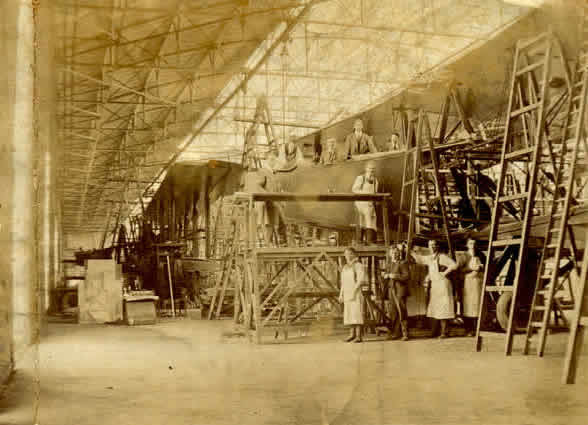| First World War Aircraft | |
|
Memorabilia
|
These aircraft are Handley Page bombers. Commodore Murray Sueter was Director of the Air Department, Admiralty, at the start of WW I. He received a message from Commander Samson, commanding an ad hoc force sent to try and stop the Germans taking Antwerp. The message was "What we need here is a bloody paralyser to stop the Hun in his tracks". Sueter gave the task of building a "bloody paralyser" to Handley Page. The design, the O/100, flew on 17 Dec 1915. HP had their factory at Cricklewood and erected the aircraft at Kingsbury, testing them at Hendon. The aircraft was improved with various modifications into the more numerous O/400 version. The external differences concern the engine installation but in the photo, the engine has yet to be fitted. So I believe that the aircraft is an O/100 or O/400 and could have been taken between 1916 and the early 1920s when some were converted to civil use.
 This is a Curtiss Flying Boat Commander John Porte was invalided out of the RN before WWI. Though an ill man, he went to the USA and became acquainted with aircraft designer Glenn Curtiss. As WWI started it became apparent that an aircraft was needed with endurance to combat U-boats and Zeppelins in the North Sea. Porte persuaded the Admiralty to buy Curtiss flying boats, but their water-borne qualities were not suited to the rough sea conditions met operating from North Sea bases. Porte designed a new hull which handled far better taxiing, taking off and landing in rough conditions. In addition the construction methods made it more robust. Porte mated his hull to the Curtiss flying surfaces and empennage and the resultant boat was a great success. Porte was CO of the RNAS establishment at Felixstowe and the main variant was known as the Felixstowe F2A. The patrol techniques they developed can be followed through to the Nimrod antisubmarine tactics of today. The boats were involved in some epic fights with German seaplanes and acquitted themselves well. The boats were contracted to be built by The Aircraft Manufacturing Company, Hendon. However, it appears to me that they devolved this to their subsidiary, May, Harden and May at Hythe. This makes sense as to fly them out after assembly required water - they were not amphibians. They were also built in the USA and by Saunders at East Cowes. Porte was an "unsung hero" of WWI and died of his long time illness on 22 Oct 1919, aged only 35.The photo shows a completed aircraft. The engines were originally "handed", but after June 1918 they both turned the same way to ease spares problems. The photo shows the later configuration, thus giving an "earliest" date. I am intrigued by the bow armament. The boats had either a single or paired machine gun installation. The picture seems to show two guns, but pointing in different directions! Guns were installed for each mission and removed to the armoury afterwards. I surmise that these weapons were used in the erection shop to test the mountings and have been put in position to "dress" the photo by the obviously proud team. Later boats dispensed with the side screens round the cockpit.
|
| Top of Page |
